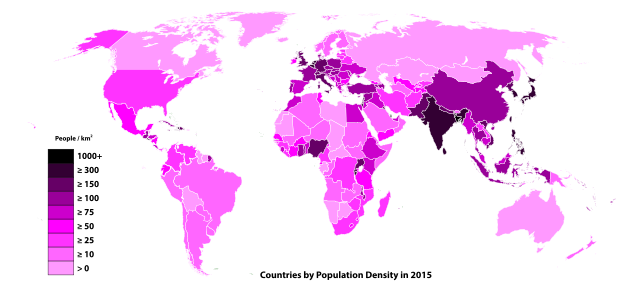
Map of population density by country, per square kilometer
On April 21, 1915, American ecologist and philosopher Garrett James Hardin was born. Hardin warned of the dangers of overpopulation. His exposition of the tragedy of the commons, in a famous 1968 paper in Science, called attention to “the damage that innocent actions by individuals can inflict on the environment“. He is also known for Hardin’s First Law of Human Ecology:
“We can never do merely one thing. Any intrusion into nature has numerous effects, many of which are unpredictable.”
– Garrett James Hardin
Academic Career
Hardin graduated in zoology from the University of Chicago in 1936 and received his doctorate in microbiology from Stanford University in 1941. From 1946 he did research at the University of California, Santa Barbara, where he held a chair in human ecology from 1963 to 1978.
The Tragedy of the Commons
Garrett Hardin’s major field of research was human overpopulation. He published controversial works, for instance advocating abortion rights and on strict limits to non-western immigration. In his 1968 essay “The tragedy of the commons“, Garrett Hardin addresses human population growth, the use of the Earth’s natural resources, and the welfare state. In it, Hardin cited the 1833 work by the English economist William Forster Lloyd that deals with herders sharing a common parcel of land, which would lead to overgrazing. In Hardin’s work, the author blames the welfare state for allowing the tragedy of the commons, in which the government provides for children and supports over-breeding as a fundamental human right. Hardin concludes that this way a Malthusian catastrophe, a prediction of a forced return to subsistence-level conditions once population growth has outpaced agricultural production, will become inevitable. However, in his 1968 essay Hardin did not call for ‘ecodictatorship’. On the contrary, he shows understanding for individual interests and writes “Who enjoys taxes? We all grumble about them.” After the change of perspective, however, it will become clear that taxes or tariffs are necessary for the maintenance of public goods. It should be noted that while Hardin writes of “extension in morality” as a solution to the tragedy of the commons, he means a change of perspective. Hardin had no training in ethics and is accordingly imprecise in his choice of words, and in his essay he explicitly opposes common moral instruments such as talking into conscience.
A Controversial Work
For his controversial work Hardin is denounced by environmental historians Joachim Radkau, Alfred Thomas Grove and Oliver Rackham “as an American with no notion at all how Commons actually work“. Hardin’s work further contradicted Elinor Ostrom‘s work on co-operative structures like the management of common land. For her work, Ostrom shared the 2009 Nobel Memorial Prize in Economic Sciences together with Oliver E. Williamson. Further, Garrett Hardin’s work was denounced as historically inaccurate for failing to account for the demographic transition, and for failing to distinguish between common property and open access resources.
Living in a Liveboat
Continuing his controversies in 1974, Hardin published the article “Living on a Lifeboat” in BioScience magazine, arguing that contributing food to help the Ethiopian famine would add to overpopulation, which he considered the root of Ethiopia’s problems. Hardin was further supported the Pioneer Fund that funds controversial research on the topic of race and intelligence, which is accused of promoting scientific racism.
The Ostrich Factor
The Ostrich Factor: Our Population Myopia was Hardin’s last published book. In it, he warns about the threat of overpopulation to the Earth’s sustainable economic future, called for coercive constraints on “unqualified reproductive rights”. He further argues that affirmative action is a form of racism.
Hardin is one of the 52 co-signatories to Mainstream Science on Intelligence, written by Linda Gottfredson and published by the Wall Street Journal in December 1994. In September 2003 Hardin, who suffered from a heart disorder and the aftermath of childhood poliomyelitis, committed suicide together with his wife.
Garrett Hardin on the Tragedy of the Commons and Resources, [8]
References and Further Reading:
- [1] “Cold War Pastures: Garrett Hardin and the ’Tragedy of the Commons‘”, Fabien Locher
- [2] Garrett Hardin Society
- [3] Hardin, G (1968). “The Tragedy of the Commons”. Science. 162 (3859): 1243–1248.
- [4] Garrett Hardin at the NY Times
- [5] Garrett Hardin at Wikidata
- [6] Robert Malthus and the Principle of Population, SciHi Blog
- [7] Obituary at American Scientist
- [8] Garrett Hardin on the Tragedy of the Commons and Resources, Video copyright 1990 Educational Communications, Inc. PO Box 351419, Los Angeles, CA 90035. 310.559.9160. Permission required for other than personal viewing., human4832 @ youtube
- [9] Locher, Fabien (2013). “Cold War Pastures: Garrett Hardin and the ‘Tragedy of the Commons’“. Revue d’Histoire Moderne et Contemporaine. 60 (1): 7–36.
- [10] Timeline of Scientists who committed Suicide, according to Wikidata and DBpedia





